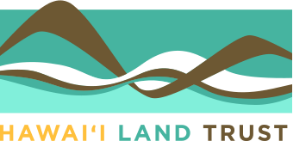Kuleana, Pilina, and Aina: Reflections from HILT's CEO Laura Kaakua
After three months with Hawaiian Islands Land Trust, I am humbled by the immense kuleana of the Land Trust. The duality of kuleana is that it is both an obligation and a privilege. We have existing kuleana to care for the six preserves which we own throughout the islands, and to annually monitor and enforce the terms of forty conservation easements restricting privately-owned land. These protected places include habitat for native and endangered species, wahi kupuna or places of our ancestors, and fertile lands that produce food that feeds our families. In the Hawaiian worldview, land is the chief, man is the servant, as passed down in the olelo noeau "he alii ka aina, he kauwa ke kanaka". Our kuleana can therefore sometimes feel heavy, but there is also great joy in the work.
That joy comes from HILT's role in facilitating connection or pilina to aina. I find joy witnessing passionate educators at Waihee Coastal Dunes and Wetland Refuge teaching Pomaikai Elementary School students about mauka-makai connections. I am filled with joy and pride listening to Hauula youth telling ancient stories of area navigators and whales at the base of Maunawila heiau. When a light rain falls as HILT Kauai Island Councilmember Mehana Vaughn and her children start to chant honoring the places of Kilauea that surround us by the Wai Koa Loop Trail, there is joy in the many unseen connections. There is also hopeful joy in working on future protection efforts such as with Kona community members to restore and protect sandalwood forest on former pasture land.
Welcoming community onto the lands we steward so that they can form, strengthen, and deepen their own pilina to aina is at the core of our work. Aina literally means that which feeds. Within our Hawaiian word for land exists the vital concept of reciprocity. If we take care of the land, it will feed, nourish and sustain current and future generations. Practicing reciprocity is how we form pilina to aina. The Land Trust's camping policy is an example of how we embed these practices in how we welcome people on the aina we steward. We welcome camping at HILT's Waihe'e and Nu'u, Maui lands, but before anyone can camp, they must volunteer on the aina. We give before we receive. Through working the land, volunteers begin to form their own pilina to aina, and when they camp, they see the land through a stewardship lens. Not only do they pick up after themselves, but they collect marine debris, and often jump in to help with other volunteer projects. In return, the aina provides through starry skies, waking up to the sound of waves and birds, and memories made with friends and family. As we care for the aina under our current stewardship, and look to protect other threatened special places, we will uphold our kuleana, and welcome communities to deepen their own pilina to aina.
Aloha Aina.
— Laura H. E. Kaakua, CEO
